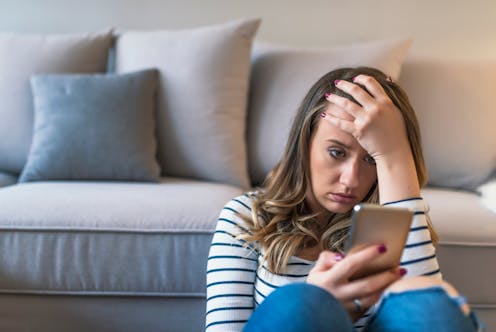Apps against sexual violence have been tried before. They don't work
- Written by Kathryn Henne, Professor and Director, School of Regulation and Global Governance, Australian National University

Yesterday, New South Wales Police Commissioner Mick Fuller suggested technology should be part of the solution to growing concerns around sexual assault. He encouraged serious discussion about using a digital app to record positive sexual consent.
In our research, we have studied a wide range of mobile applications and artificial intelligence (AI) chatbots used in attempts to counter sexual violence over the past decade. We found these apps have many limitations and unexpected consequences.
How apps are being used to address sexual abuse
Apps aimed at responding to sexual harassment and assault have circulated for at least a decade. With support from government initiatives, such as the Obama administration’s 2011 Apps Against Abuse challenge, and global organisations, such as UN Women, they have been implemented in corporate environments, universities and mental health services.
These apps are not limited to documenting consent. Many are designed to offer emergency assistance, information and a means for survivors of sexual violence to report and build evidence against perpetrators. Proponents often frame these technologies as empowering tools that support women through the accessible and anonymous processing of data.
In the case of the proposed consent app, critics have noted that efforts to time-stamp consent fail to recognise consent can always be withdrawn. In addition, a person may consent out of pressure, fear of repercussions or intoxication.
If a person does indicate consent at some point but circumstances change, the record could be used to discredit their claims.
How digital apps fail to address sexual violence
The use of apps will not address many longstanding problems with common responses to sexual violence. Research indicates safety apps often reinforce rape myths, such as the idea that sexual assault is most often perpetrated by strangers. In reality, the vast majority of rapes are committed by people the victims already know.
Usually marketed to women, these apps collect data from users through surveillance using persistent cookies and geolocational tracking. Even “anonymised” data can often be identifiable.
Digital tools can also enable violence. Abusive partners can use them for cyberstalking, giving them constant access to victims. Apps designed to encourage survivors to report violence raise similar concerns, because they fail to address the power imbalances that lead to authorities discrediting survivors’ accounts of violence.
Apps don’t change the bigger picture
The introduction of an app does not itself change the wider landscape in which sexual violence cases are handled.
The high-profile sex abuse scandal involving Larry Nassar, a former USA Gymnastics and Michigan State University doctor convicted of a range of sex offences after being accused by more than 350 young women and girls, led to reforms that included the SafeSport app.
This resulted in 1,800 reports of sexual misconduct or abuse within a year of the app’s introduction. However, a lack of funding meant the reports could not be properly investigated, undermining organisational promises to enforce sanctions for sexual misconduct.
Read more: Anti-rape devices may have their uses, but they don't address the ultimate problem
Poor implementation and cost-saving measures compromise users’ safety. In Canada and the United States, the hospitality industry is rolling out smart panic buttons to 1.2 million hotel and casino staff. This is a response to widespread sexual violence: a union survey found 58% of employees had been sexually harassed by a guest and 65% of casino workers experienced unwanted touching.
Employers are now required by law to provide panic buttons, but they are turning to cheap and inferior devices, raising security concerns. Legislation does not prevent them using these devices to monitor the movements of their employees.
Who owns the data?
Even if implemented as intended, apps raise questions about data protection. They collect vast amounts of sensitive data, which is stored on digital databases and cloud servers that are vulnerable to cyberattacks.
Read more: The ugly truth: tech companies are tracking and misusing our data, and there's little we can do
The data may be owned by private companies who can sell it on to other organisations, allowing authorities to circumvent privacy laws. Last month, it was revealed US Immigration and Customs Enforcement purchased access to the Reuters CLEAR database containing information about 400 million people whose data they could not legally collect on their own.
In short, apps don’t protect victims or their data.
Why we need to take this ‘bad idea’ seriously
Fuller, the NSW police commissioner, admitted his recommendation might be a bad idea. His idea was built on the premise that the important issue to address is making sure consent is clearly communicated. It misunderstands the nature of sexual violence, which is grounded in unequal power relations.
In practice, a consent app would be unlikely to protect victims. Research shows data collected through new forms of investigation often result in evidence that is used against victims’ wishes.
There are other reasons why the consent app is a bad idea. It perpetuates misguided assumptions about technology’s ability to “fix” societal harms. Consent, violence and accountability are not data problems. These complex issues require strong cultural and structural responses, not simply quantifiable and time-stamped data.
Authors: Kathryn Henne, Professor and Director, School of Regulation and Global Governance, Australian National University



















